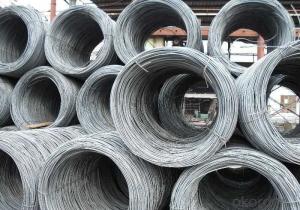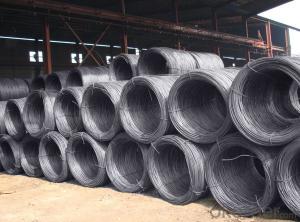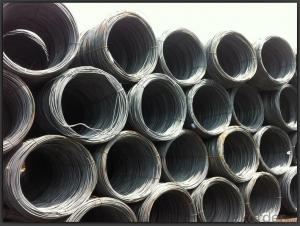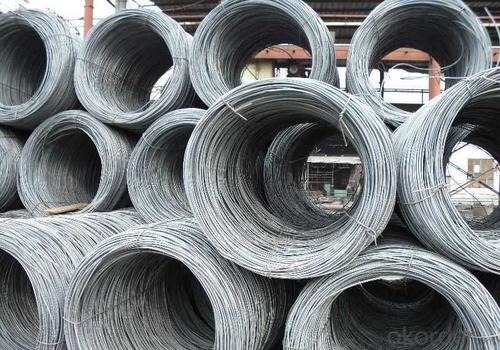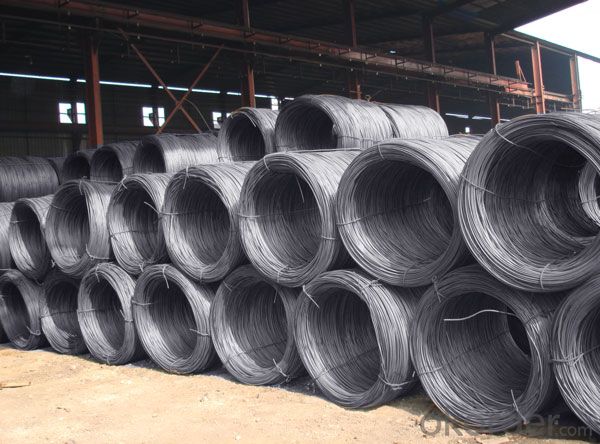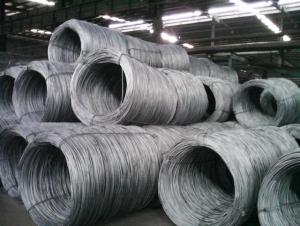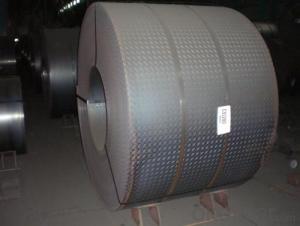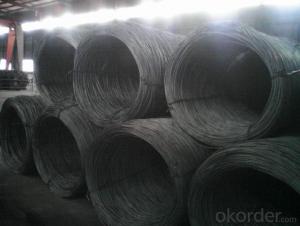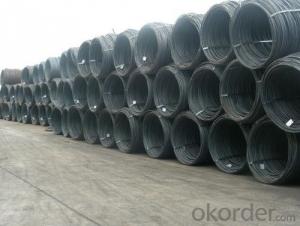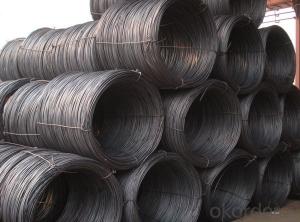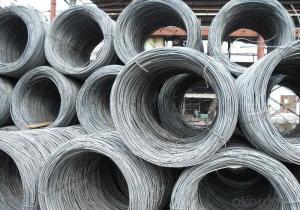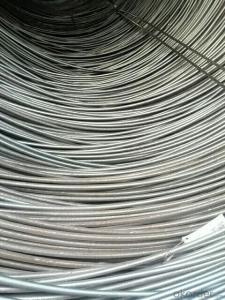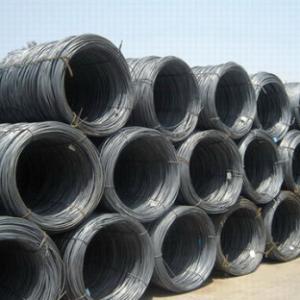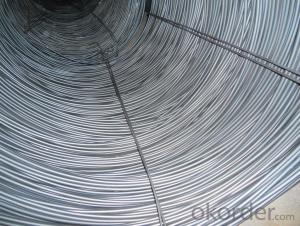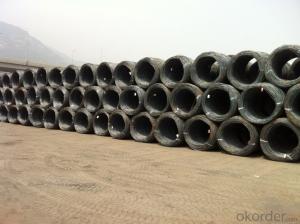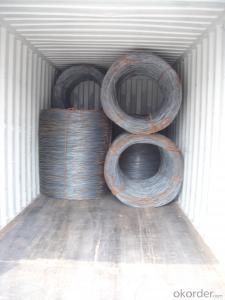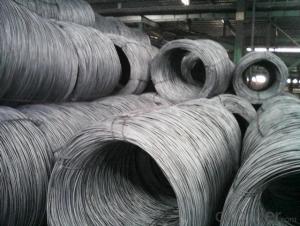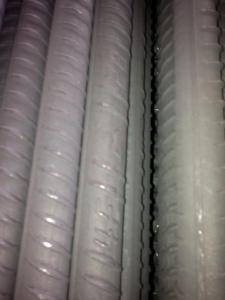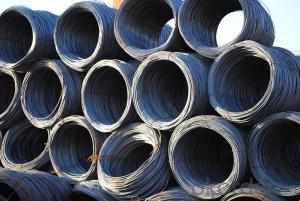hot rolled wire rod SAE1006-1018B 5.5MM-14MM
- Loading Port:
- Tianjin
- Payment Terms:
- TT OR LC
- Min Order Qty:
- 25 m.t.
- Supply Capability:
- 20000000 m.t./month
OKorder Service Pledge
OKorder Financial Service
You Might Also Like
WIRE ROD Details:
| Minimum Order Quantity: | m.t. | Unit: | m.t. | Loading Port: | |
| Supply Ability: | m.t./month | Payment Terms: | TT OR LC |
Product Description:
Steel Grade: Q195 Standard: ASTM, GB
Diameter: 5.5mm, 6.5mm, 7mm,8mm,9mm,10mm,12mm,14mm
6.5mm can be drawing into 2mm/8.0mm can be drawing into 3mm
Type: Drawn Wire in Coil, each coil weight about 2MT
Brand Name: N-RIVER Place of Origin: Hebei, China
Chemical Composition:
Please kindly find our chemistry of our material based on Q195 as below for your information
Trademark | Rank | Chemical composition (quality score) % | |||||
C | Si | Mn | S | P | |||
| ≤ |
| ≤ | ≤ | |||
Q195 |
| 0.06-0.12 | 0.30 | 0.25 | 0.050 | 0.045 | |
Trademark | Rank | Pulling Test | |||||
Bend PointΔs/Mpa | Tensile Strength | Elongation Ratioδ5% | |||||
Thickness (Diameter) /MM | Thickness (Diameter) /MM | ||||||
≤16 | 16-40 | ≤16 | 16-40 | ||||
≥ | ≥ | ||||||
Q195 |
| 195 | 185 | 315-390 | 33 | 32 | |
Usage and Applications of Wire Rod Q195:
After hot-rolled the products shaped into coil and delivery as finished product, including round, square, rectangular, hexagonal and so on. Since most of the products are round, it is generally called wire rod. Carbon steel wire rod is widely used in construction and manufacturing. Carbon steel wire rod is mainly used for reinforcement of reinforced concrete and welded structure or reprocessed (roberts , nail, etc.) materials, especially used to produce wire drawing, welding electrode, nails, spring, electronic, precise machinery parts and so on
- Q: How is steel wire rod used in the production of wire for automotive seat springs?
- The production of wire for automotive seat springs relies heavily on steel wire rod, which is an indispensable component. To enhance its mechanical properties, such as strength, durability, and flexibility, the wire rod undergoes a series of steps involving heating and cooling. Once the steel wire rod has been processed, it is drawn down further to achieve the desired diameter for the seat springs. This drawing process entails pulling the wire rod through a set of dies, simultaneously reducing its diameter and increasing its length. This step is critical to attaining the desired mechanical properties and ensuring that the wire can withstand the stress and pressure experienced by automotive seat springs. Once the wire has reached the desired diameter, it is then shaped into the specific coil form required for the seat springs. Through the use of specialized machinery, the wire is coiled and molded into the desired shape, ensuring that it meets the design requirements and provides the necessary support and comfort for automotive seats. The use of steel wire rod in wire production for automotive seat springs is crucial due to its exceptional tensile strength and resistance to fatigue and corrosion. These properties enable the wire to withstand the constant pressure and movement experienced by automotive seat springs, resulting in long-lasting performance and durability. Additionally, steel wire rod offers the advantages of being cost-effective and readily available, making it the preferred choice for automotive manufacturers. Its versatility allows for customization, enabling the production of wire with specific characteristics tailored to meet the requirements of different types of seat springs. In conclusion, steel wire rod plays a vital role in the production of wire for automotive seat springs. Through various processing steps, the wire rod is transformed into high-quality wire that possesses the necessary strength, durability, and flexibility to support and provide comfort to automotive seats.
- Q: What are the different surface finishes available for steel wire rods?
- There are several different surface finishes available for steel wire rods, each offering unique properties and benefits. Some of the common surface finishes include: 1. Black Oxide Finish: This finish is achieved by applying a chemical treatment to the surface of the steel wire rod, resulting in a black-colored oxide layer. It provides increased corrosion resistance and improved lubricity. 2. Galvanized Finish: In this process, the steel wire rod is coated with a layer of zinc, which provides excellent corrosion resistance. Galvanized wire rods are commonly used in outdoor applications or environments with high humidity. 3. Electroplated Finish: This finish involves applying a thin layer of metal, such as nickel or chromium, to the surface of the steel wire rod through an electroplating process. It enhances the appearance, corrosion resistance, and durability of the wire rod. 4. Powder Coated Finish: Powder coating involves applying a dry powder to the surface of the steel wire rod and then heating it to form a protective and decorative layer. This finish provides excellent resistance to chipping, scratching, and corrosion. 5. Phosphated Finish: Phosphating is a chemical process that forms a layer of phosphate crystals on the surface of the steel wire rod. It improves the adhesion of subsequent coatings, enhances corrosion resistance, and promotes better lubrication. 6. Bare or Natural Finish: In this case, the steel wire rod is left untreated, with no additional coatings or finishes applied. It is typically used in applications where aesthetics are not a concern, and the primary focus is on strength and durability. The choice of surface finish for steel wire rods depends on the specific application requirements, such as corrosion resistance, appearance, lubrication, and environmental conditions.
- Q: What are the mechanical properties of steel wire rod?
- The mechanical properties of steel wire rod mainly include its tensile strength, yield strength, elongation, and hardness. These properties determine the wire rod's ability to withstand applied forces, its flexibility, and its resistance to deformation.
- Q: What are the common applications of high-strength steel wire rod?
- High-strength steel wire rods have a wide range of applications across various industries due to their exceptional strength and durability. Some of the common applications of high-strength steel wire rods include: 1. Automotive industry: High-strength steel wire rods are extensively used in the automotive industry for manufacturing various components such as springs, suspension systems, seat frames, and reinforcement bars. The high tensile strength of these wire rods ensures enhanced safety and stability in vehicles. 2. Construction industry: Steel wire rods find extensive use in the construction industry for reinforcement purposes. They are commonly used to strengthen concrete structures such as bridges, buildings, and highways. The high strength and ductility of these wire rods make them ideal for withstanding heavy loads and seismic forces. 3. Manufacturing industry: High-strength steel wire rods are widely used in the manufacturing industry for producing a variety of products, including cables, wire mesh, nails, screws, and fasteners. The superior strength and durability of these wire rods make them suitable for applications that require resistance to bending, twisting, and tension. 4. Aerospace industry: High-strength steel wire rods find applications in the aerospace industry for manufacturing aircraft components. They are used in the production of cables, control systems, landing gear, and engine components. The high strength-to-weight ratio of these wire rods plays a crucial role in ensuring the safety and reliability of aircraft structures. 5. Energy sector: Steel wire rods are commonly used in the energy sector for various applications. They are utilized in power transmission lines, suspension cables for bridges and power plants, and wire ropes for lifting heavy equipment. The high tensile strength and corrosion resistance of these wire rods make them suitable for withstanding the demanding conditions of the energy sector. 6. Consumer goods: High-strength steel wire rods are also used in the manufacturing of consumer goods such as furniture, appliances, and sporting equipment. They are employed in the production of springs for mattresses and chairs, wire frames for household appliances, and components for fitness equipment. The durability and reliability of these wire rods contribute to the longevity of consumer products. Overall, the common applications of high-strength steel wire rods span across industries, including automotive, construction, manufacturing, aerospace, energy, and consumer goods. Their exceptional strength, durability, and versatility make them a preferred choice for various applications where reliability and performance are crucial factors.
- Q: How is the impact resistance of steel wire rod tested?
- The impact resistance of steel wire rod is typically tested using a Charpy impact test. In this test, a notched specimen of the wire rod is subjected to a swinging pendulum that strikes and breaks the specimen. The energy absorbed by the specimen during fracture is measured, which provides an indication of its impact resistance.
- Q: Can steel wire rod be used in the production of nails?
- Yes, steel wire rod can be used in the production of nails.
- Q: What are the common industry developments for steel wire rod?
- Some common industry developments for steel wire rod include advancements in production technology to improve efficiency and reduce costs, increasing focus on sustainability and environmental impact, and the development of new and improved alloys for enhanced strength and performance. Additionally, there is a growing trend towards automation and digitalization in wire rod manufacturing processes to optimize operations and ensure consistent quality.
- Q: How can steel bars and bars be differentiated from each other in different uses?
- Wire rod used before the use of steel straightening machine, straightening, blanking, but also in the machine to remove oxidation rust skin, but also in repeated bending and stretching, the intensity has improved.
- Q: What are the different types of steel wire rod coatings used for improved electrical conductivity?
- There are several types of steel wire rod coatings used for improved electrical conductivity, including copper, tin, silver, and nickel. These coatings help enhance the wire's ability to conduct electricity by reducing resistance and improving the flow of electrical current.
- Q: What are the different types of wire mesh made from steel wire rod?
- There are several different types of wire mesh made from steel wire rod, including welded wire mesh, woven wire mesh, expanded metal mesh, and perforated metal mesh. Each type of mesh has its own unique characteristics and applications. Welded wire mesh is made by welding individual wires together to form a grid pattern, and it is commonly used for fencing, reinforcement, and construction purposes. Woven wire mesh is created by weaving individual wires together in a specific pattern, and it is often used for filtration, screening, and decorative purposes. Expanded metal mesh is produced by cutting and stretching a metal sheet, creating a diamond-shaped pattern, and it is commonly used for grating, walkways, and security applications. Perforated metal mesh is made by punching holes in a metal sheet, and it is often used for filtration, ventilation, and facade applications.
Send your message to us
hot rolled wire rod SAE1006-1018B 5.5MM-14MM
- Loading Port:
- Tianjin
- Payment Terms:
- TT OR LC
- Min Order Qty:
- 25 m.t.
- Supply Capability:
- 20000000 m.t./month
OKorder Service Pledge
OKorder Financial Service
Similar products
Hot products
Hot Searches
Related keywords
